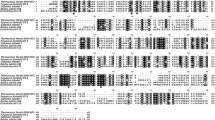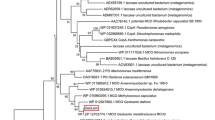Abstract
Marinomonas mediterranea is a marine gamma-proteobacterium that synthesizes LodA, a novel l-lysine-ε-oxidase (E.C. 1.4.3.20). This enzyme oxidizes L-lysine generating 2-aminoadipate 6-semialdehyde, ammonium, and hydrogen peroxide. Unlike other l-amino acid oxidases, LodA is not a flavoprotein but contains a quinone cofactor. LodA is encoded by an operon with two genes, lodA and lodB. In the native system, LodB is required for the synthesis of a functional LodA. In this study, we report the recombinant expression of LodA in Escherichia coli using vectors that allow its expression and accumulation in the cytoplasm. To reveal the l-lysine-ε-oxidase activity using the Amplex Red method for hydrogen peroxide detection, it is necessary to first remove the E. coli cytoplasmic catalases. The flavoprotein LodB is the only M. mediterranea protein required in the recombinant system for the generation of the cofactor of LodA. In the absence of LodB, LodA does not contain the quinone cofactor and remains in an inactive form. The results presented indicate that LodB participates in the posttranslational modification of LodA that generates the quinone cofactor.






Similar content being viewed by others
References
Barsby T (2006) Drug discovery and sea hares: bigger is better. Trends Biotechnol 24:1–3
Bollinger JA, Brown DE, Dooley DM (2005) The formation of lysine tyrosylquinone (LTQ) is a self-processing reaction. Expression and characterization of a Drosophila lysyl oxidase. Biochemistry 44:11708–11714
Campillo-Brocal JC, Lucas-Elío P, Sanchez-Amat A (2013) Identification in Marinomonas mediterranea of a novel quinoprotein with glycine oxidase activity. MicrobiologyOpen 2(4):684–694
Davidson VL, Liu A (2012) Tryptophan tryptophylquinone biosynthesis: a radical approach to posttranslational modification. Biochim Biophys Acta (BBA) - Proteins Proteomics 1824:1299–1305
Dym O, Eisenberg D (2001) Sequence-structure analysis of FAD-containing proteins. Protein Sci 10:1712–1728
Gomez D, Lucas-Elio P, Sanchez-Amat A, Solano F (2006) A novel type of lysine oxidase: L-lysine-epsilon-oxidase. Biochim Biophys Acta 1764:1577–1585
Gomez D, Lucas-Elio P, Solano F, Sanchez-Amat A (2010) Both genes in the Marinomonas mediterranea lodAB operon are required for the expression of the antimicrobial protein lysine oxidase. Mol Microbiol 75:462–473
Graichen ME, Jones LH, Sharma BV, van Spanning RJM, Hosler JP, Davidson VL (1999) Heterologous expression of correctly assembled methylamine dehydrogenase in Rhodobacter sphaeroides. J Bacteriol 181:4216–4222
Janes SM, Mu D, Wemmer D, Smith AJ, Kaur S, Maltby D, Burlingame AL, Klinman JP (1990) A new redox cofactor in eukaryotic enzymes: 6-hydroxydopa at the active site of bovine serum amine oxidase. Science 248:981–987
Laemmli UK (1970) Cleavage of structural proteins during the assembly of the head of bacteriophage T4. Nature 227:680–685
Lucas-Elio P, Hernandez P, Sanchez-Amat A, Solano F (2005) Purification and partial characterization of marinocine, a new broad-spectrum antibacterial protein produced by Marinomonas mediterranea. Biochim Biophys Acta 1721:193–203
Lucas-Elio P, Gomez D, Solano F, Sanchez-Amat A (2006) The antimicrobial activity of marinocine, synthesized by Marinomonas mediterranea, is due to hydrogen peroxide generated by its lysine oxidase activity. J Bacteriol 188:2493–2501
Lucas-Elio P, Goodwin L, Woyke T, Pitluck S, Nolan M, Kyrpides NC, Detter JC, Copeland A, Teshima H, Bruce D, Detter C, Tapia R, Han S, Land ML, Ivanova N, Mikhailova N, Johnston AW, Sanchez-Amat A (2012) Complete genome sequence of the melanogenic marine bacterium Marinomonas mediterranea type strain (MMB-1T). Stand Genomic Sci 6:63–73
Lukasheva EV, Efremova AA, Treshalina EM, Arinbasarova AY, Medentzev AG, Berezov TT (2011) L-Amino acid oxidases: properties and molecular mechanisms of action. Biochem Moscow Suppl Ser B 5:337–345
Mai-Prochnow A, Lucas-Elio P, Egan S, Thomas T, Webb JS, Sanchez-Amat A, Kjelleberg S (2008) Hydrogen peroxide linked to lysine oxidase activity facilitates biofilm differentiation and dispersal in several Gram-negative bacteria. J Bacteriol 190:5493–5501
Matsuda M, Asano Y (2010) Determination of plasma and serum L-lysine using L-lysine epsilon-oxidase from Marinomonas mediterranea NBRC 103028(T). Anal Biochem 406:19–23
McIntire WS, Wemmer DE, Chistoserdov A, Lidstrom ME (1991) A new cofactor in a prokaryotic enzyme: tryptophan tryptophylquinone as the redox prosthetic group in methylamine dehydrogenase. Science 252:817–824
Mure M (2004) Tyrosine-derived quinone cofactors. Acc Chem Res 37:131–139
Nakai T, Ono K, Kuroda S, Tanizawa K, Okajima T (2012) An unusual subtilisin-like serine protease is essential for biogenesis of quinohemoprotein amine dehydrogenase. J Biol Chem 287:6530–6538
Ono K, Okajima T, Tani M, Kuroda S, Sun D, Davidson VL, Tanizawa K (2006) Involvement of a putative [Fe-S]-cluster-binding protein in the biogenesis of quinohemoprotein amine dehydrogenase. J Biol Chem 281:13672–13684
Pearson AR, Jones LH, Higgins L, Ashcroft AE, Wilmot CM, Davidson VL (2003) Understanding quinone cofactor biogenesis in methylamine dehydrogenase through novel cofactor generation. Biochemistry 42:3224–3230
Salisbury SA, Forrest HS, Cruse WB, Kennard O (1979) A novel coenzyme from bacterial primary alcohol dehydrogenases. Nature 280:843–844
Satoh A, Kim JK, Miyahara I, Devreese B, Vandenberghe I, Hacisalihoglu A, Okajima T, Kuroda S, Adachi O, Duine JA, Van BJ, Tanizawa K, Hirotsu K (2002) Crystal structure of quinohemoprotein amine dehydrogenase from Pseudomonas putida. Identification of a novel quinone cofactor encaged by multiple thioether cross-bridges. J Biol Chem 277:2830–2834
Solano F, García E, Pérez de Egea E, Sanchez-Amat A (1997) Isolation and characterization of strain MMB-1 (CECT 4803), a novel melanogenic marine bacterium. Appl Environ Microbiol 63:3499–3506
Wang SX, Mure M, Medzihradszky KF, Burlingame AL, Brown DE, Dooley DM, Smith AJ, Kagan HM, Klinman JP (1996) A crosslinked cofactor in lysyl oxidase: redox function for amino acid side chains. Science 273:1078–1084
Wilmot CM, Davidson VL (2009) Uncovering novel biochemistry in the mechanism of tryptophan tryptophylquinone cofactor biosynthesis. Curr Opin Chem Biol 13:462–467
Yukl ET, Liu F, Krzystek J, Shin S, Jensen LMR, Davidson VL, Wilmot CM, Liu A (2013) Diradical intermediate within the context of tryptophan tryptophylquinone biosynthesis. PNAS 110:4569–4573
Acknowledgments
This work has been supported by grants BIO2010-15226 (Ministerio de Ciencia e Innovación, Spain) and 11867/PI/09 (Fundación Séneca, CARM, Spain) (co-financed by the European Commission, FEDER funds).
We thank Alejandro Torrecillas and the Molecular Biology Service of the University of Murcia for their support on MS analysis.
Author information
Authors and Affiliations
Corresponding author
Rights and permissions
About this article
Cite this article
Chacón-Verdú, M.D., Gómez, D., Solano, F. et al. LodB is required for the recombinant synthesis of the quinoprotein l-lysine-ε-oxidase from Marinomonas mediterranea . Appl Microbiol Biotechnol 98, 2981–2989 (2014). https://doi.org/10.1007/s00253-013-5168-3
Received:
Revised:
Accepted:
Published:
Issue Date:
DOI: https://doi.org/10.1007/s00253-013-5168-3




